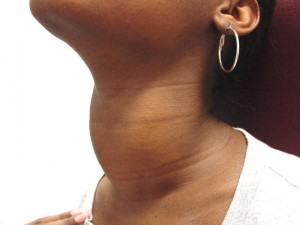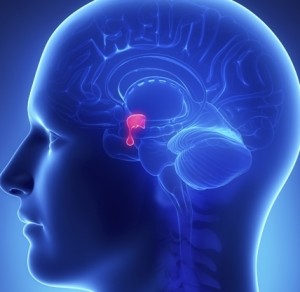1. Hashimoto’s Disease
Rationale:
Patient presents with weight gain, lack of energy, sleepiness, cold intolerance, difficulty swallowing, throat feels swollen, and voice is hoarse. On focused physical assessment she has brittle hair and an enlarged thyroid gland. According to her MRI results, she also has an enlarged pituitary gland.
2. Graves’ Disease

http://ashlandscience.shoutwiki.com/wiki/Graves_Disease
Rationale:
Graves’, like Hashimoto’s, is also an autoimmune disease. The most common symptom is goiter formation. Graves’ disease results from a form of type II hypersensitivity in which there is stimulation of the thyroid by auto-antibodies known as thyroid-stimulating immunoglobulin (TSI), directed against the TSH receptor, overriding normal regulatory mechanisms. The TSI stimulation of TSH receptors in the gland results in hyperplasia causing a goiter (McCance & Heuther, 2014).
Criteria for diagnosis:
• Physical Examination
- Look for enlargement of thyroid gland (may need to use ultrasound to look for enlargement).
- Exophthalmoses (protruding of the eyeball)
- Assess for resting tremors.
- Signs & symptoms are opposite of hypothyroid.
- Vital signs
- Tachycardia.
- Hypertension.
- Phlebotomy
- Lower than normal TSH levels.
- Higher levels of T3 and T4.
- Look for the antibody specific to Graves disease (TSI).
Radioactive Iodine Uptake: The body needs iodine to make thyroid hormones so a small amount of radioactive iodine is given and later, the amount of it in the thyroid gland is measured with a specialized scanning camera to determine the rate at which the thyroid gland takes up iodine.
The amount of iodine taken up by the thyroid gland can help determine if Graves’ disease or another condition is the cause of the hyperthyroidism (mayoclinic.org, 2014).
3. Hypopituitarism

http://www.brainline.org/content/2014/06/can-symptoms-of-hypopituitarism-present-years-after-a-brain.html
Rationale:
Signs and symptoms of hypofunction of the anterior pituitary are variable and depend on which hormones are affected. When TSH is affected, signs and symptoms mimic Hashimoto hypothyroid disease, making it difficult to differentiate between the two diagnoses (McCance & Heuther, 2014).
Criteria for Diagnosis:
- Signs & Symptoms:
- Decreased TSH levels
- Cold intolerance
- Dryness of skin
- Lethargy
- Decreased metabolic rate
- Mild myedema
- Combined with Testing:
- Measurements of tropic hormones from the pituitary and target endocrine glands.
- MRI and/or CT scans may demonstrate enlargement of pituitary gland.
4. Thyroid Cancer
Rationale: One of the symptoms of thyroid cancer is a lump in the front of the throat as the abnormal cells begin to enlarge and multiply, many times being misdiagnosed as a goiter.
Criteria for Diagnosis:
- Physical exam and patient and family history:
- Lumps or swelling in the neck, voice box, and/or lymph nodes.
- Hoarseness.
- Difficulty swallowing, or breathing.
- Patient/Family Hx:
- Between 25 and 65 years old.
- Female.
- Exposure to radiation to the head and neck as a child– the cancer may occur as soon as 5 years after exposure.
- History of goiter.
- Personal or family history of thyroid disease or thyroid cancer.
- Asian decent.
- Combined with Testing:
- Laryngoscopy – A thyroid tumor may press on vocal cords.
- Blood hormone studies- Check for abnormal levels of thyroid-stimulating hormone (TSH).
- T3 and T4, usually, will be normal (McCance & Heuther, 2014).
- Ultrasound or CT scan – Show the size of a thyroid tumor and whether it is solid or a fluid -filled cyst.
- Fine-needle aspiration biopsy of the thyroid: To remove several tissue samples from different parts of the thyroid then a pathologist views the tissue samples under a microscope to look for cancer cells (cancer.gov, 2015).
- Surgical biopsy: The removal of the thyroid nodule or one lobe of the thyroid during surgery so the cells and tissues can be viewed under a microscope by a pathologist to check for signs of cancer (cancer.gov, 2015).
